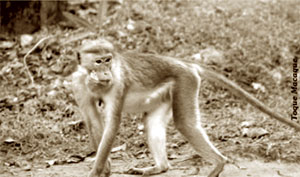A Mammalian cause!
|

Red Slender Loris |
Sri
Lanka is home to 17 endemic mammals. Being an island Sri Lanka lacks
land area to supports large animals. However, fossil evidence of large
archaic species of Rhinoceroses, Hippopotamuses, and Lions have been
discovered. The flora and fauna of Sri Lanka is mostly understudied.
Therefore the number of endemics is could be underestimated. Most
endemic mammals are small nocturnal mammals that are seen rarely.
Red Slender Loris
The Red Slender Loris (Loris tardigradus) is a small, nocturnal
prosimian native to the rainforests of Sri Lanka. This is 6th of the 10
focal species and 22th of the 100 EDGE animal species worldwide
considered the most Evolutionarily Distinct and Globally Endangered. Two
subspecies have been identified, L.t.tardigradus and L.t. nycticeboides.
This small, slender primate is distinguished with large forward
facing eyes used for precise depth perception, long slender limbs, a
well-developed index finger, the absence of tail, and large prominent
ears, which are thin, rounded and hairless at the edges.
The soft dense fur is reddish-brown color on the back and the
underside is whitish-grey with a sprinkling of silver hair. Its body
length on average is 7–10 in (180–250 mm), with an average weight of a
mere 3–13 oz (85–370 g). This loris has a four way grip on each foot.
The big toe opposes the other 4 toes for a pincer like grip on branches
and food. It has a dark face mask with central pale stripe, much like
the slow lorises.
The Red Slender Loris favors lowland rainforests (up to 700 m in
altitude), tropical rainforests and inter-monsoon forests of the south
western wet-zone of Sri Lanka. Masmullah Proposed Forest Reserve harbors
one of few remaining Red Slender Loris populations, and is considered a
biodiversity hotspot. The Red Slender Loris differ from its close
relative the Gray Slender Loris in its frequent use of rapid arboreal
locomotion. It forms small social groups, containing adults of both
sexes as well as young animals.
This species is among the most social of the nocturnal primates.
Habitat destruction is a major threat. It is widely trapped and killed
for use in supposed remedies for eye diseases and get killed by snakes,
dogs, and some fish.
Other threats include: electrocution on live wires, road accidents
and the pet trade.
Toque Macaque
|

Toque Macaque |
The
Toque Macaque (Macaca sinica) is a reddish-brown coloured Old World
monkey endemic to both Sri Lanka and southern tip of India, where it is
locally known as the ‘Rilewa’ or ‘Rilawa’ (hence ‘Rillow’ in the Oxford
English Dictionary). It is named for the Toque shaped whorl of hair on
its head, rather like the bonnet of the related Bonnet Macaque. It lives
in troops, sometimes numbering up to 20, and has developed into three
subspecies. It has a head and body length of 35–55 cm (14–22 in), a tail
length of 40–60 cm (16–24 in) and can weigh up to 8.4 kg (19 lb). Troops
of the Toque Macaque are a common sight in Sri Lanka’s Cultural
Triangle, where many ancient temples are situated, hence earning them
the nickname of “Temple Monkey”.
There are two subspecies of Toque Macaque that have been described -
they are the dryzone Toque Macaque (Macaca sinica sinica), Wetzone Toque
Macaque (Macaca sinica aurifrons)
Purple-faced langur
|

Purple Faced Langur |
The Purple-faced Langur (Trachypithecus vetulus), or Purple-faced
Leaf Monkey, is a species of Old World monkey endemic to Sri Lanka.
This is a long-tailed arboreal species, mainly brown with a dark
facemask and paler lower face. The loud barking call, particularly of
the highland form, can be mistaken for the roar of a predator such as a
leopard. This was once a common species, which was found even in
suburban Colombo and in the wet zone villages, but rapid urbanisation
has taken a toll on the numbers of these monkeys.
It is said to be very selective in its diet, and its range has
contracted greatly in the face of human encroachment, although it can
still be seen in Sinharaja, Kitulgala, in the mountains at Horton Plains
National Park or in the rainforest city of Galle. |

